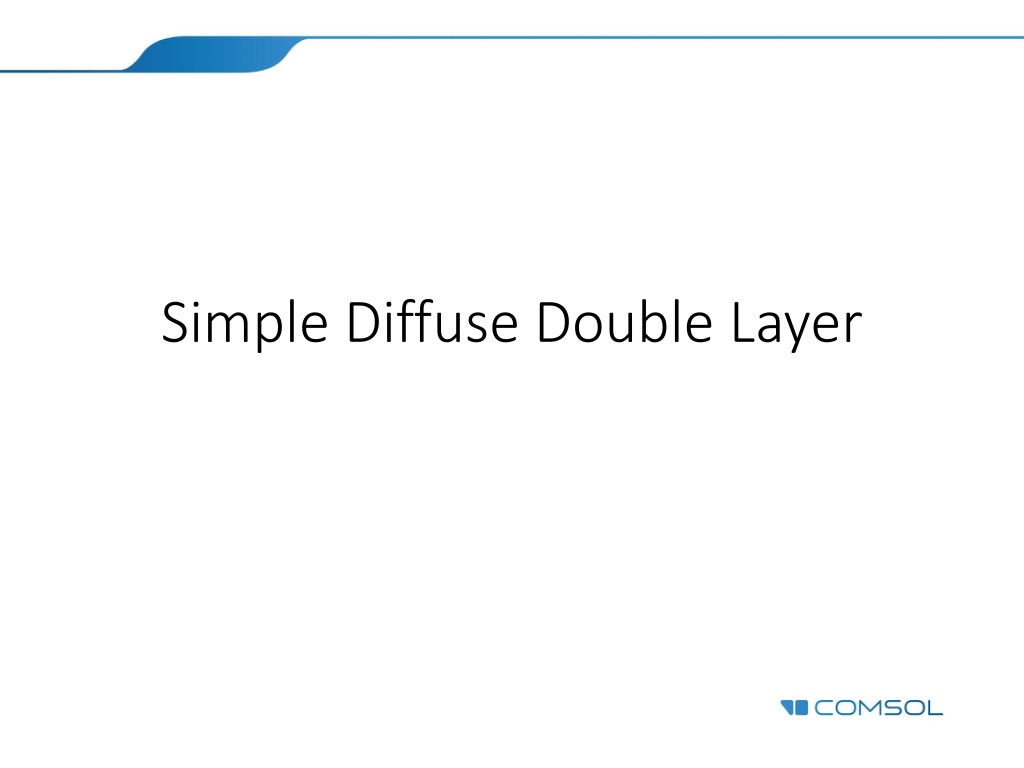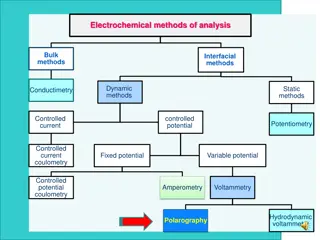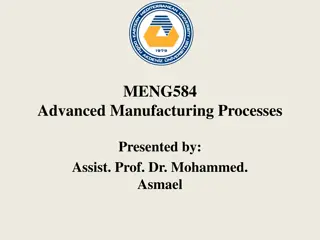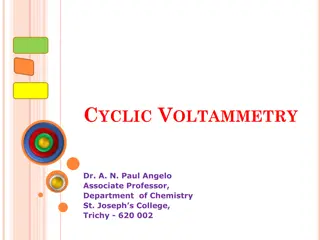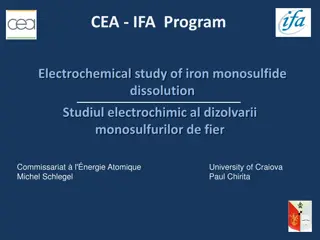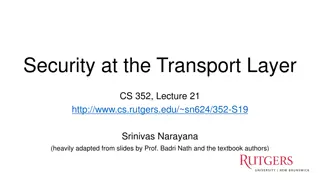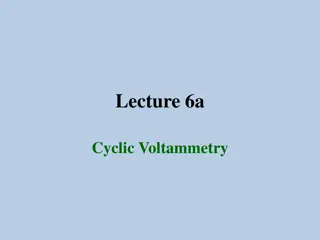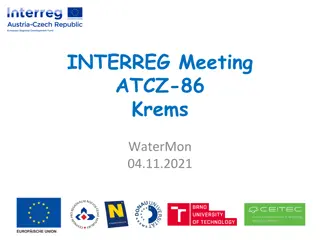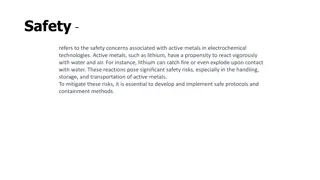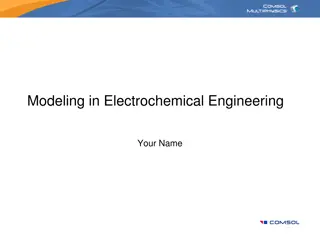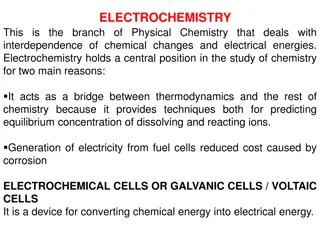Understanding Electrochemical Double Layer Theory
Electrochemical double layer theory explains the distribution of charges and ions at the interface between an electrode and an electrolyte solution. It involves concepts like space charge density, Nernst-Planck equations, and Gouy-Chapman theory to describe the behavior of ions and electric fields in the system.
Download Presentation

Please find below an Image/Link to download the presentation.
The content on the website is provided AS IS for your information and personal use only. It may not be sold, licensed, or shared on other websites without obtaining consent from the author. Download presentation by click this link. If you encounter any issues during the download, it is possible that the publisher has removed the file from their server.
E N D
Presentation Transcript
Double layer theory When a polarizable electrode is held at a certain voltage compared to a reference, it will have a corresponding net surface charge density. This charge attracts or repels ions in the neighboringsolution, depending on their charge. electrode electrode electrolyte electrolyte double layer (space charge) bulk solution (electroneutral) At equilibrium, there is a layer of space charge density adjacent to the electrode due to unequal amounts of different types of ions. The charge in solution is equal and opposite to the charge on the electrode: double layer . charge = +Q charge = -Q charge = 0 Simplified schematic of the double layer.
Electrostatics The electric field obeys Gauss s law. assume that solvent permittivity is unaffected by ion density (dilute solution). assume that only dissolved ions contribute to the space charge density in solution. E = soln i 0 = F z ic i E = electric field (V/m) = space charge density (C/m3) soln = solvent dielectric constant 0 = vacuum permittivity F = Faraday constant (= absolute charge on one mole of electrons) zi = charge number of ion i ci= concentration of ion i(mol/m3)
Dilute species transport Dilute species (low concentration) obey the Nernst-Planck equations for mass transport. flux includes diffusion and migration terms assume no reactions in solution (no source term) c + = N 0 i i t = + N E D c z c u i i i i i i F u = D i i RT Ni= molar flux of ion i (mol/(m2*s)) Di= diffusion coefficient of ion i(m2/s) ui= electrical mobility of ion i(m2/s/V) R= gas constant T= temperature (K)
Nernst-Planck-Poisson equations Combine the equations at steady-state. Nernst Nernst- -Planck Planck- -Poisson Poisson Poisson- -Nernst Nernst- -Planck equations describes charge and mass distribution in dilute electrolyte. for n ions, gives (n+1) equations in (n+1) unknowns: n ion concentrations electric potential ( ) Poisson (or Planck) F + = 0 D c z D c i i i i i RT F i + = 2 0 z c i i soln 0
Gouy-Chapman theory Key prediction of Gouy- Chapman theory: extent of the double layer (region of space charge density) is of the order of the Debye length xD. Solve Nernst-Planck-Poisson equations at steady-state to find double layer structure. Specify a charge density or fixed potential at the electrode surface. Set electroneutral bulk concentrations and zero electrical potential at large distance. RT = soln I 0 x D 2 2 F ion 1 i = 2 I z ic ion , bulk 2 i
Stern modification (GCS theory) Account for potential drop across the region from the metal surface to the centre line of the closest approach of an ion. This line is called the outer Helmholtz plane (OHP). Region outside the OHP is the diffuse double layer where there is space charge due to ion excess / depletion. Region inside the OHP is the compact double layer or Stern layer where the electric field is near-constant. = surf x OHP M S soln 0 Treat the solvent inside the OHP as a classical rectilinear dielectric of fixed length (xS), usually < 1 nm.
Setup (interfaces and domains) Couple Electrostatics Electrostatics with Transport of Diluted Transport of Diluted Species Species. Solve for as many concentrations as there are ions. Add a Space Charge Space Charge Density Density to electrostatics according to the ion concentrations.
Setup (electrode boundary) Electrode: Electrode: Set a Surface Charge Surface Charge Density Density in Electrostatics The surface charge density is a function of the applied voltage and the local electric potential according to the Stern expression. Set No Flux No Flux of ions (no electrode reaction). Electrostatics.
Setup (bulk boundary) Bulk: Bulk: Set Ground Bulk boundary must be several Debye lengths from the surface in order that the electric field tends to zero here. Set Concentration Concentration condition to define bulk ion concentrations. Bulk ion concentrations must be defined to give a neutral solution. Ground in Electrostatics Electrostatics.
Results Parametric sweep on voltage vs potential of zero charge (PZC) of the working electrode, from 1 to 10 mV. Potential and concentration profiles for the double layer. Output rho_surf to find surface charge.
Electric potential (M = 10 mV) Electric potential plot showing: potential drop in the Stern layer (a few %) finite extent of the diffuse double layer, over a few Debye lengths.
Concentrations (M = 10 mV) Concentration profile showing: depletion of cations and excess of anions at a positively charged surface nanometer extent of the diffuse double layer.
Surface charge density Relation of double layer voltage to charge. The derivative of this plot gives the differential capacitance of the electrode. For low voltages vs PZC, GCS theory gives: = soln 0 C A DL + x x D S Note the small positive deviation at higher voltage where the low voltage linearization is less accurate. There is a general exact solution (at higher potential) but it is more verbose! (Ais electrode area)
References and further reading Original papers: L.G. Gouy, C. R. Hebd. S ances Acad. Sci., 1909, 149 149, 654 657. D.L. Chapman, Philos. Mag., 1913, 25 25, 475 481. O. Stern, Z. Elektrochem., 1924, 30 30, 508 516. Reference works: Chapter 7: Structure of the Electrical Double Layer in J. Newman and K.E. Thomas-Alyea, Electrochemical Systems, 3rd ed., 2004, Wiley. Chapter 13: Double-Layer Structure and Adsorption in Electrochemical Methods: Fundamentals and Applications, 2nd ed., 2001, Wiley.
